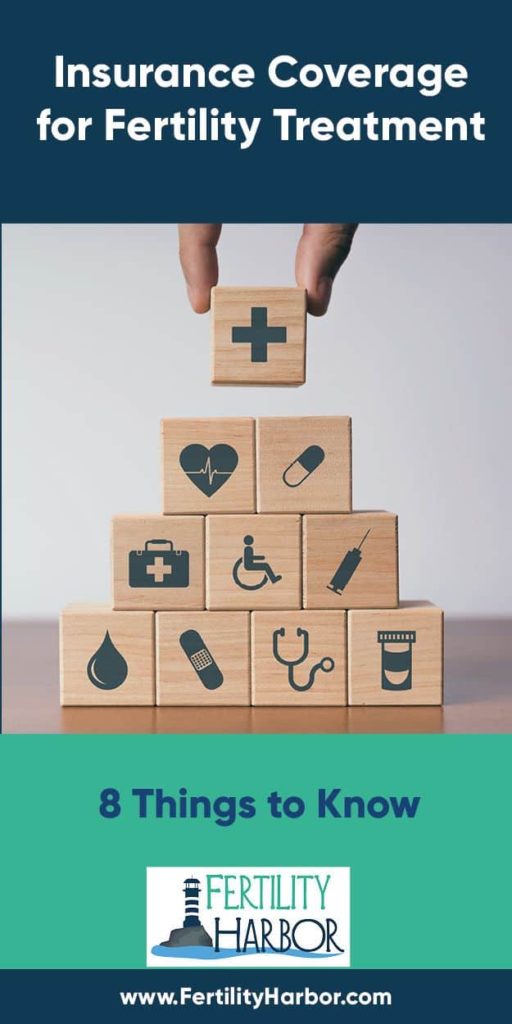This post was reviewed for medical accuracy by Rosalie Gunson, a Certified Registered Nurse Practitioner specializing in fertility care.
Budgeting for fertility treatment in the United States is really challenging. It’s impossible to know if any particular protocol will be successful until you try it, and the true costs of healthcare are not exactly transparent.
You have probably heard horror stories about people triple-mortgaging their homes to pay for IVF. I’m not going to pretend it’s cheap. But while health insurance coverage for fertility treatment is not yet universal, it is slowly improving.
Advocacy organizations like Resolve and Fertility Within Reach are making great strides, and many progressive companies have chosen to expand their coverage for infertility treatment to keep their employees happy. Shady Grove has said that 90% of their patients have coverage for the initial consult, and 70% have at least some coverage for testing and treatment. That’s definitely progress!
If you’re contemplating fertility treatment and you’re wondering how you are going to afford it, the first thing to do is to understand the details of any health insurance coverage you have.
1) Insurance plans vary widely. Make sure you know the details of your exact plan.
In most states, there is no requirement to cover infertility treatment at all. That’s partly because the federal Affordable Care Act (Obamacare) does not include infertility treatment as an “essential health benefit.”
In addition, health insurance companies offer an assortment of plans tailored to different markets. Even if you and your friend both have insurance through Anthem BCBS, for instance, the actual plans could be very different. You really can’t draw any conclusions about your own coverage based on someone else’s experience with the same insurance company.
So it’s crucial to understand what your specific plan entails. Obviously you can talk to the health insurance company directly, but if you have health insurance through your employer or your spouse’s employer, the company’s HR department can also help you navigate the system.
If you are told you do not have coverage for “infertility treatment,” don’t leave it at that! Not everything will be coded as “infertility treatment” when your provider bills your insurance. You may well have coverage for blood tests, ultrasounds, medications, and other elements of a treatment cycle.
More info about these tests can be found in Do Transvaginal Ultrasounds Hurt? and Does an HSG Hurt? What to Expect.
The best time to figure all this out is when you are approaching your annual open enrollment period. This is the window of time when you can change your benefits elections easily.
Now that you know you will be needing infertility treatment, you can compare your options and crunch some numbers. You might decide to switch plans, if your employer offers more than one, or jump on your spouse’s plan if that’s a better option.
2) If you have a male partner, his insurance coverage and medical history are important too.
Speaking of your spouse’s plan: If you have a male partner and he’s not on the same health plan as you are, make sure you understand the details of his plan too. At minimum, he will be sent for a semen analysis as part of the fertility workup. Without insurance coverage, this test usually costs around $150.
A semen analysis will tell you, among other things:
- Sperm count (the number of sperm in one milliliter of semen),
- Sperm morphology (the percentage of sperm that have a normal shape), and
- Sperm motility (the percentage of sperm that can move normally).
If the results are normal, you’re all set! If the semen analysis suggests any issues, your partner may be referred to a reproductive urologist for further evaluation. Then his insurance coverage for specialists would come into play.
Your coverage may also depend on what fertility interventions you’ve already tried and both people’s medical history. You may have to jump through some hoops, like doing 6 IUIs before they will cover IVF. (Ugh!)
Regardless of what your plan includes, your insurance company may refuse to cover your fertility treatment if you or your partner previously had a tubal ligation or a vasectomy.
I’m grateful that we had excellent health insurance when I was TTC, but we did run into one annoying issue regarding IUIs. My insurance company would have paid for my IUIs if our sample came from a donor, but not from my husband. Because of this rule, we had to pay out-of-pocket for each of my 4 IUIs. For more info on the cost of IUIs specifically, see my post How Much Does an IUI Cost Without Insurance?
3) If your plan covers fertility medications, you will probably have to use a specialty pharmacy, and you will probably need to have your doctor fill out paperwork in advance.
You can get basic prescriptions like Metformin and progesterone supplements from any ol’ pharmacy, but to get injectable meds and trigger shots you will probably have to use a specialty mail-order pharmacy. Popular specialty pharmacies include Freedom Fertility, Walgreens Specialty, and CVS Caremark Specialty.
When my doctor and I decided to switch to injectables, I discovered that a single month of Gonal-F would have cost as much as a mortgage payment. Luckily, my insurance company covered Follistim (which is basically the same thing) for a very reasonable co-pay.
So if you find out that your insurance company does not cover a particular brand of medication, push them to see what they will cover. Is there a generic available, and if so, how much is it? (For example, letrozole is the generic equivalent of Femara, as I explain in the post Are Letrozole and Femara the Same Thing?)
Figuring out how much fertility injections would cost was pretty frustrating. The conversation went something like this:
- ME: Here’s my 700-digit insurance ID number, my Social Security number, my mother’s maiden name, and the name of my first dog. How much would Gonal-F cost?
- INSURANCE COMPANY: That’s a specialty medication. You have to speak to the specialty pharmacy.
- SPECIALTY PHARMACY: We are not showing that you have an approved prescription for that.
- ME: I don’t yet. I am trying to find out how much it would be, to see if I can afford it.
- SPECIALTY PHARMACY: But you don’t have an approved prescription.
- ME: I know. But hypothetically, what would it cost me?
- SPECIALTY PHARMACY: We will let you know if you are approved after your doctor fills out a huge form.
- ME: *Bangs head against desk*
Waiting for the pre-authorizations can delay the start of your next medicated cycle. It’s worth putting up with the run-around if there’s any chance you will have coverage for fertility prescriptions, though. Follistim and Gonal-F typically cost around $1 per unit, which means that a 900-unit pen costs about $900. Depending on how you respond to the injections, you might need more than 900 units for one cycle (I did).
The posts When to Consider Moving on to Injectable Fertility Meds and Why Are So Many Fertility Medications Refrigerated? have more info about fertility injections.
4) Ask about discounts or programs available for people in your situation.
There are various grants, financial aid, and scholarship programs for people dealing with infertility who fit into certain demographics, such as:
- Veterans
- Active duty military
- Cancer patients or survivors (fertility preservation)
- Residents of particular regions, states, counties, or cities
- Members of particular religions, especially Judaism
While you may not think of “self-paying” as a demographic, people paying cash can sometimes negotiate their own discounts with providers and pharmacies. It certainly doesn’t hurt to ask!
5) Don’t forget about your FSA if you have one.
An FSA, or Flexible Spending Plan, lets you set aside pre-tax money for certain qualifying medical (and dental) expenses. What’s a qualifying medical expense, you ask? Ah, the devil is in the details.
Since this is about taxes, the IRS has a whole list of expenses that are FSA-eligible. Here are some examples of expenses that are relevant to fertility and reproductive health:
Just a Few Examples of FSA-Eligible Expenses:
- Health insurance co-pays, deductibles, and co-insurance
- Fertility treatment (for self, spouse, or dependent)
- Lab tests
- Over-the-counter pregnancy tests
- Ovulation predictor kits
- Birth control pills
- Condoms
- Sterilization (ex: tubal ligation, vasectomy) or reversals
- Breast pumps
- Childbirth classes
- Prenatal vitamins
Just a Few Examples of Things an FSA Will Not Cover:
- Health insurance premiums
- Fertility treatment for surrogate*
- Tampons
- Maternity clothes
- General vitamins (without a prescription/ not used to treat a specific condition)
*Regarding surrogacy, you can’t use an FSA for the gestational surrogate’s medical costs (because she’s not a member of your family), but you may be able to use an FSA for the parts of the IVF process that occur before the transfer.
Using an FSA for the tax benefits may not matter much to you if you are not in a high tax bracket or the item you’re buying is pretty cheap (like a bottle of vitamins). You can’t put an unlimited amount of money in an FSA anyway. (In 2025, the annual limit is $3,300.)
But one handy feature of the FSA is that the entire amount is available at the beginning of the plan year — even though your contributions will be deducted from each check over the course of the year. So you can use it to pay for things you may not necessarily have the cash on hand for.
As I’ve said, we didn’t have health insurance coverage for our IUIs, but we did have FSA funds available. We used our FSA to pay for $1200 worth of IUIs, although they happened in two different calendar years. That brings me to my next point.
6) Consider the potential impact of the calendar.
Health insurance goes according to the plan year, which is usually the same as a calendar year. Flexible Spending Plans are a form of tax benefits, so they go by the tax year. But fertility treatment can easily span more than one year, so you should be mindful when these benefits reset.
- If you have fertility coverage but a high deductible, you may want to see if you can get as much treatment as you can done in the same calendar year before you have to pay another deductible.Of course, when you get your BFP, the actual pregnancy is likely to span two plan years (unless you get pregnant very early in the year). You may end up owing that high deductible again when it’s time to deliver the baby. You can only plan so much!
- If you’re paying out of pocket, it may make sense to get as much treatment as you can done in the same calendar year so you have enough deductions to itemize on your federal tax return.
Disclaimer: This is intended as general information only. I am not a tax expert! For advice about your particular financial situation, please consult a qualified accountant.
7) Look into payment plans at your fertility clinic.
Fertility centers offer various payment options, and some even come with guarantees. For example, here are some of the current options available at Shady Grove:
- You can choose to pay per IVF cycle, which typically is about $10k (not including medications, which add another $5k to $8k). This includes one fresh embryo transfer, but does not include frozen embryo transfers if you are not pregnant after the first fresh transfer. One frozen embryo cycle transfer costs about $5k.
- Shady Grove also offers a multi-cycle discount. For an up-front cost of about $18k, you can get two IVF cycles and unlimited frozen embryo transfers. That $18k does not include medications, but it’s still a deal compared to paying the full cost of those two IVF cycles out-of-pocket.
- The third option is the Shared Risk 100% refund program. In this program, you get six fresh IVF cycles and unlimited frozen embryo transfers for $20k to $28k (the exact price depends on age). The beauty of this plan is that you get your money back if you don’t take home a baby.Shady Grove was the first clinic to offer a program like this, and many other clinics are now offering some variation of it.The Shared Risk program is not for everyone, though. You obviously need to have a large enough budget to participate, and you have to meet various criteria. For example, women approved for the program can be no older than 40, and their AMH and FSH must be normal.
8) Advocate for expanded insurance coverage at your workplace and in your state.
If your fertility coverage isn’t great, see if you can do something about it. For example, talk to your HR department about adding a plan with better infertility coverage next year.
In the absence of feedback, HR departments don’t know what elements of insurance plans are important to their employees. It’s not like they have a list of every employee’s medical conditions — that would be creepy, not to mention illegal!
Improving requirements for fertility coverage is another approach you can take, especially if your state is lagging behind the curve. Here is a letter I wrote in support of proposed legislation here in New Hampshire.
Conclusion
For too many couples, infertility is financially as well as physically and emotionally devastating. Having health insurance that will cover at least some of the cost is critical to helping more people expand their families.
For More Information:
“The Policymaker’s Guide to Fertility Health Benefits” by Fertility Within Reach
This post was last updated in March 2025. Most of its content was written in 2020.



 I’m Jenn! Here I am with my beautiful twin boys. My pregnancy was possible thanks to fertility treatment for PCOS.
I’m Jenn! Here I am with my beautiful twin boys. My pregnancy was possible thanks to fertility treatment for PCOS.


